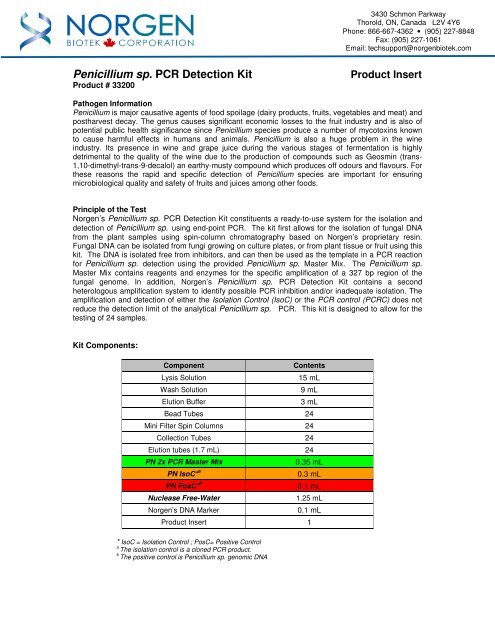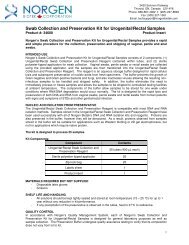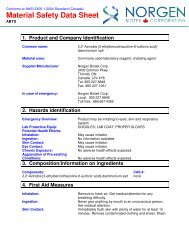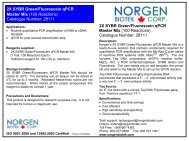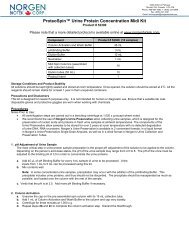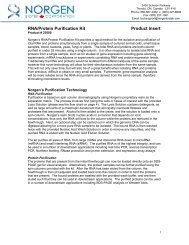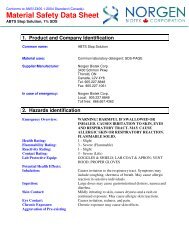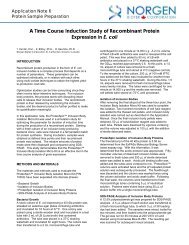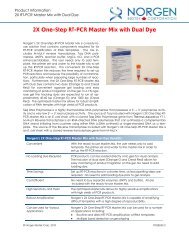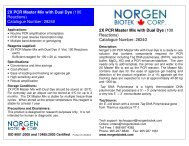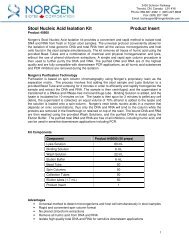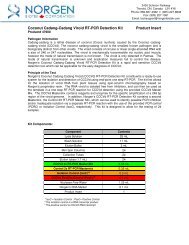Penicillium sp. PCR Detection Kit - Norgen Biotek
Penicillium sp. PCR Detection Kit - Norgen Biotek
Penicillium sp. PCR Detection Kit - Norgen Biotek
You also want an ePaper? Increase the reach of your titles
YUMPU automatically turns print PDFs into web optimized ePapers that Google loves.
<strong>Penicillium</strong> <strong>sp</strong>. <strong>PCR</strong> <strong>Detection</strong> <strong>Kit</strong> Product Insert<br />
Product # 33200<br />
Pathogen Information<br />
<strong>Penicillium</strong> is major causative agents of food <strong>sp</strong>oilage (dairy products, fruits, vegetables and meat) and<br />
postharvest decay. The genus causes significant economic losses to the fruit industry and is also of<br />
potential public health significance since <strong>Penicillium</strong> <strong>sp</strong>ecies produce a number of mycotoxins known<br />
to cause harmful effects in humans and animals. <strong>Penicillium</strong> is also a huge problem in the wine<br />
industry. Its presence in wine and grape juice during the various stages of fermentation is highly<br />
detrimental to the quality of the wine due to the production of compounds such as Geosmin (trans-<br />
1,10-dimethyl-trans-9-decalol) an earthy-musty compound which produces off odours and flavours. For<br />
these reasons the rapid and <strong>sp</strong>ecific detection of <strong>Penicillium</strong> <strong>sp</strong>ecies are important for ensuring<br />
microbiological quality and safety of fruits and juices among other foods.<br />
Principle of the Test<br />
<strong>Norgen</strong>’s <strong>Penicillium</strong> <strong>sp</strong>. <strong>PCR</strong> <strong>Detection</strong> <strong>Kit</strong> constituents a ready-to-use system for the isolation and<br />
detection of <strong>Penicillium</strong> <strong>sp</strong>. using end-point <strong>PCR</strong>. The kit first allows for the isolation of fungal DNA<br />
from the plant samples using <strong>sp</strong>in-column chromatography based on <strong>Norgen</strong>’s proprietary resin.<br />
Fungal DNA can be isolated from fungi growing on culture plates, or from plant tissue or fruit using this<br />
kit. The DNA is isolated free from inhibitors, and can then be used as the template in a <strong>PCR</strong> reaction<br />
for <strong>Penicillium</strong> <strong>sp</strong>. detection using the provided <strong>Penicillium</strong> <strong>sp</strong>. Master Mix. The <strong>Penicillium</strong> <strong>sp</strong>.<br />
Master Mix contains reagents and enzymes for the <strong>sp</strong>ecific amplification of a 327 bp region of the<br />
fungal genome. In addition, <strong>Norgen</strong>’s <strong>Penicillium</strong> <strong>sp</strong>. <strong>PCR</strong> <strong>Detection</strong> <strong>Kit</strong> contains a second<br />
heterologous amplification system to identify possible <strong>PCR</strong> inhibition and/or inadequate isolation. The<br />
amplification and detection of either the Isolation Control (IsoC) or the <strong>PCR</strong> control (<strong>PCR</strong>C) does not<br />
reduce the detection limit of the analytical <strong>Penicillium</strong> <strong>sp</strong>. <strong>PCR</strong>. This kit is designed to allow for the<br />
testing of 24 samples.<br />
<strong>Kit</strong> Components:<br />
Component Contents<br />
Lysis Solution 15 mL<br />
Wash Solution 9 mL<br />
Elution Buffer 3 mL<br />
Bead Tubes 24<br />
Mini Filter Spin Columns 24<br />
Collection Tubes 24<br />
Elution tubes (1.7 mL) 24<br />
PN 2x <strong>PCR</strong> Master Mix 0.35 mL<br />
PN IsoC* a 0.3 mL<br />
PN PosC* b 0.1 mL<br />
Nuclease Free-Water 1.25 mL<br />
<strong>Norgen</strong>’s DNA Marker 0.1 mL<br />
Product Insert 1<br />
* IsoC = Isolation Control ; PosC= Positive Control<br />
a The isolation control is a cloned <strong>PCR</strong> product.<br />
b The positive control is <strong>Penicillium</strong> <strong>sp</strong>. genomic DNA<br />
3430 Schmon Parkway<br />
Thorold, ON, Canada L2V 4Y6<br />
Phone: 866-667-4362 • (905) 227-8848<br />
Fax: (905) 227-1061<br />
Email: techsupport@norgenbiotek.com
Customer-Supplied Reagents and Equipment<br />
• Di<strong>sp</strong>osable powder-free gloves<br />
• Benchtop microcentrifuge<br />
• 1.5 mL microcentrifuge tubes<br />
• 65°C water bath or heating block<br />
• 96 – 100% ethanol<br />
• 70% ethanol<br />
• RNase A (optional)<br />
• Lyticase (optional)<br />
Storage Conditions and Product Stability<br />
All buffers should be kept tightly sealed and stored at room temperature (15-25 o C). Buffers can be<br />
stored for up to 1 year without showing any reduction in performance.<br />
The <strong>Penicillium</strong> <strong>sp</strong>. 2x <strong>PCR</strong> Master Mix, <strong>Penicillium</strong> <strong>sp</strong>. Positive Control (PosC) and the <strong>Penicillium</strong><br />
<strong>sp</strong>. Isolation Control (IsoC) should be kept tightly sealed and stored at -20 o C for up to 1 year without<br />
showing any reduction in performance. Repeated thawing and freezing (> 2 x) should be avoided, as<br />
this may reduce the sensitivity. If the reagents are to be used only intermittently, they should be frozen<br />
in aliquots.<br />
General Precautions<br />
The user should exercise the following precautions when using the kit:<br />
• Use sterile pipette tips with filters.<br />
• Store and extract positive material (<strong>sp</strong>ecimens, controls and amplicons) separately from all<br />
other reagents and add it to the reaction mix in a <strong>sp</strong>atially separated facility.<br />
• Thaw all components thoroughly at room temperature before starting an assay.<br />
• When thawed, mix the components and centrifuge briefly.<br />
• Work quickly on ice.<br />
Quality Control<br />
In accordance with <strong>Norgen</strong>’s ISO 9001 and ISO 13485-certified Quality Management System, each lot<br />
of <strong>Norgen</strong>’s <strong>Penicillium</strong> <strong>sp</strong>. <strong>PCR</strong> <strong>Detection</strong> <strong>Kit</strong>, including the <strong>Penicillium</strong> <strong>sp</strong> 2x <strong>PCR</strong> Master Mix,<br />
<strong>Penicillium</strong> <strong>sp</strong> Isolation Control (IsoC) and <strong>Penicillium</strong> <strong>sp</strong> Positive Control (PosC) are tested against<br />
predetermined <strong>sp</strong>ecifications to ensure consistent product quality.<br />
Product Use Limitations<br />
<strong>Norgen</strong>’s <strong>Penicillium</strong> <strong>sp</strong>. <strong>PCR</strong> <strong>Detection</strong> <strong>Kit</strong> is designed for research purposes only. It is not intended<br />
for human or diagnostic use.<br />
Product Warranty and Satisfaction Guarantee<br />
NORGEN BIOTEK CORPORATION guarantees the performance of all products in the manner<br />
described in our product manual. The customer must determine the suitability of the product for its<br />
particular use.<br />
Safety Information<br />
Ensure that a suitable lab coat, di<strong>sp</strong>osable gloves and protective goggles are worn when working with<br />
chemicals. For more information, please consult the appropriate Material Safety Data Sheets<br />
(MSDSs). These are available as convenient PDF files online at www.norgenbiotek.com.<br />
CAUTION: DO NOT add bleach or acidic solutions directly to the sample-preparation waste.
Protocol<br />
A. <strong>Penicillium</strong> <strong>sp</strong>. Genomic DNA Isolation<br />
Important Notes Prior to Beginning Protocol:<br />
• A variable <strong>sp</strong>eed centrifuge should be used for maximum kit performance. If a variable <strong>sp</strong>eed<br />
centrifuge is not available a fixed <strong>sp</strong>eed centrifuge can be used, however reduced yields may<br />
be observed.<br />
• Ensure that all solutions are at room temperature prior to use, and that no precipitates have<br />
formed. If necessary, warm the solutions and mix well until the solutions become clear again.<br />
• Prepare a working concentration of the Wash Solution by adding 21 mL of 96 - 100 %<br />
ethanol (provided by the user) to the supplied bottle containing the concentrated Wash<br />
Solution. This will give a final volume of 30 mL. The label on the bottle has a box that may<br />
be checked to indicate that the ethanol has been added.<br />
• Lysate can be prepared from either fungi growing on plates, plant tissue or fruit. Please<br />
ensure that you follow the proper procedure for lysate preparation in Step 1a.<br />
• For the isolation of genomic DNA from fungi growing on plates, Collection Solution must be<br />
prepared. Collection Solution consists of 0.9% (w/v) NaCl prepared with distilled water.<br />
• Preheat a water bath or heating block to 65°C.<br />
• <strong>Penicillium</strong> <strong>sp</strong>. Isolation Control ( IsoC)<br />
� A <strong>Penicillium</strong> <strong>sp</strong>. Isolation Control (IsoC) is supplied. This allows the user to control<br />
the DNA isolation procedure. For this assay, add the <strong>Penicillium</strong> <strong>sp</strong>. Isolation Control<br />
(IsoC) to the lysate during the isolation procedure<br />
� The <strong>Penicillium</strong> <strong>sp</strong>. Isolation Control (IsoC) must not be added to the sample<br />
material directly.<br />
� Do not freeze and thaw the <strong>Penicillium</strong> <strong>sp</strong>. Isolation Control (IsoC) more than 2<br />
times.<br />
� The <strong>Penicillium</strong> <strong>sp</strong>. Isolation Control (IsoC) must be kept on ice at all times during<br />
the isolation procedure.<br />
• The <strong>PCR</strong> components of the <strong>Penicillium</strong> <strong>sp</strong>. <strong>PCR</strong> <strong>Detection</strong> <strong>Kit</strong> should remain at -20 o C until<br />
DNA is extracted and ready for <strong>PCR</strong> amplification.<br />
1. Lysate Preparation<br />
a. Fungi Growing on Plates: Add approximately 5 mL (volume can be adjusted based on<br />
density of fungal growth) of Collection Solution (see notes before use) to the plate and<br />
gently collect fungal <strong>sp</strong>ores and mycelium with an inoculation loop or autoclaved pipette tip,<br />
ensuring not to collect any agar debris. Transfer up to 1 mL of washed <strong>sp</strong>ores and wet<br />
mycelium to a microcentrifuge tube (provided by user).<br />
Fungi from Plant Tissue or Fruit: Wash the tissue or fruit with an appropriate amount of<br />
DNAse free water with vortexing. Transfer up to 1 mL of washed <strong>sp</strong>ores and wet mycelium to<br />
a microcentrifuge tube (provided by user).<br />
b. Centrifuge at 14,000 x g (~14,000 RPM) for 2 minutes to pellet the cells. Pour off the<br />
supernatant carefully so as not to disturb or dislodge the cell pellet.<br />
c. Add 500 µL of Lysis Solution to the cell pellet. Resu<strong>sp</strong>end the cells by gentle vortexing.<br />
d. Transfer the mixture to a provided Bead Tube and secure the tube horizontally on a flat-bed<br />
vortex pad with tape, or in any commercially available bead beater equipment (e.g. Scientific<br />
Industries’ Disruptor Genie TM<br />
).<br />
e. Vortex for 5 minutes at maximum <strong>sp</strong>eed or optimize the condition for any commercially<br />
available bead beater equipment.<br />
Note: Foaming during the homogenization is common. This foaming is due to detergents<br />
present in the Lysis Buffer and will not affect the protocol.
f. Incubate the Bead Tube with lysate at 65 ° C for 10 minutes. Occasionally mix the lysate 2 or 3<br />
times during incubation by inverting the tube.<br />
g. Briefly <strong>sp</strong>in the tube to remove liquid from the cap, and transfer all of the lysate, including cell<br />
debris, to a DNase-free microcentrifuge tube (provided by the user) by pipetting. Ensure that<br />
the beads are not transferred during the pipetting.<br />
h. Centrifuge the tube for 2 minute at 14000 × g (~14,000 RPM).<br />
i. Carefully transfer clean supernatant to a new DNase-free microcentrifuge tube (provided by<br />
the user) without disturbing the pellet. Note the volume.<br />
j. Add an equal volume of 70% ethanol (provided by the user) to the lysate collected above (100<br />
µL of ethanol is added to every 100 µL of lysate). Vortex to mix.<br />
k. Proceed to Step 2: Binding to Column<br />
2. Binding DNA to Column<br />
a. Assemble a <strong>sp</strong>in column with one of the provided collection tubes.<br />
b. Add 10 µL of <strong>Penicillium</strong> <strong>sp</strong>.Isolation Control (PN IsoC) to the lysate mixture.<br />
c. Apply up to 600 µL of the lysate with ethanol onto the column and centrifuge for 1 minute at<br />
14,000 x g (~14,000 RPM). Discard the flowthrough and reassemble the <strong>sp</strong>in column with the<br />
collection tube.<br />
Note: Ensure the entire lysate volume has passed through into the collection tube by<br />
in<strong>sp</strong>ecting the column. If the entire lysate volume has not passed, <strong>sp</strong>in for an additional<br />
minute.<br />
d. Depending on your lysate volume, repeat step 2c if necessary.<br />
3. Column Wash<br />
a. Apply 500 µL of Wash Solution to the column and centrifuge for 1 minute.<br />
Note: Ensure the entire wash solution has passed through into the collection tube by<br />
in<strong>sp</strong>ecting the column. If the entire wash volume has not passed, <strong>sp</strong>in for an additional<br />
minute.<br />
b. Discard the flowthrough and reassemble the column with its collection tube.<br />
c. Repeat step 3a to wash column a second time.<br />
d. Discard the flowthrough and reassemble the <strong>sp</strong>in column with its collection tube.<br />
e. Spin the column for 2 minutes in order to thoroughly dry the resin. Discard the collection tube.<br />
4. DNA Elution<br />
a. Place the column into a fresh 1.7 mL Elution tube provided with the kit.<br />
b. Add 75 µL of Elution Buffer to the column.<br />
c. Centrifuge for 2 minutes at 200 x g (~2,000 RPM), followed by a 1 minute <strong>sp</strong>in at 14,000 x g<br />
(~14,000 RPM). Note the volume eluted from the column. If the entire volume has not been<br />
eluted, <strong>sp</strong>in the column at 14,000 x g (~14,000 RPM) for 1 additional minute.<br />
5. Storage of DNA<br />
The purified DNA may be stored at –20°C for a few days. It is recommended that samples be<br />
placed at –70°C for long term storage.
B. <strong>Penicillium</strong> <strong>sp</strong>. <strong>PCR</strong> Assay Preparation<br />
Notes:<br />
• Before use, suitable amounts of all <strong>PCR</strong> components should be completely thawed at room<br />
temperature, vortexed and centrifuged briefly.<br />
• The amount of <strong>Penicillium</strong> <strong>sp</strong>. 2X <strong>PCR</strong> Master Mix provided is enough for up to 32 <strong>PCR</strong> reactions<br />
(24 sample <strong>PCR</strong>, 4 positive control <strong>PCR</strong> and 4 no template control <strong>PCR</strong>).<br />
• For every <strong>PCR</strong> run, one reaction containing <strong>Penicillium</strong> <strong>sp</strong>. Positive Control (PosC) and one<br />
reaction as no template control must be included for proper interpretation of results.<br />
• The recommended minimum number of DNA samples tested per <strong>PCR</strong> run is 6.<br />
• Using a lower volume from the sample than recommended may affect the sensitivity of <strong>Penicillium</strong><br />
<strong>sp</strong>. Limit of <strong>Detection</strong>.<br />
1. Prepare the <strong>PCR</strong> for sample detection as shown in Table 1 below. The recommended amount of<br />
sample DNA to be used is 5 µL. However, a volume between 1 and 10 µL of sample DNA may be<br />
used as template. Adjust the final volume of the <strong>PCR</strong> reaction to 20 µL using the Nuclease-Free Water<br />
provided.<br />
Table 1. <strong>PCR</strong> Assay Preparation<br />
<strong>PCR</strong> Components Volume Per <strong>PCR</strong> Reaction<br />
<strong>Penicillium</strong> <strong>sp</strong> 2X <strong>PCR</strong> Master Mix 10 µL<br />
Sample DNA 2 to 5 µL<br />
Nuclease-Free Water Up to 10 µL<br />
Total Volume 20 µL<br />
2. For every <strong>PCR</strong> run, prepare one positive control <strong>PCR</strong> as shown in Table 2 below:<br />
Table 2. <strong>PCR</strong> Positive Control Preparation<br />
<strong>PCR</strong> Components Volume Per <strong>PCR</strong> Reaction<br />
<strong>Penicillium</strong> <strong>sp</strong> 2X <strong>PCR</strong> Master Mix 10 µL<br />
<strong>Penicillium</strong> <strong>sp</strong> Positive Control (PosC) 10 µL<br />
Total Volume 20 µL<br />
3. For every <strong>PCR</strong> run, prepare one no template control <strong>PCR</strong> as shown in Table 3 below:<br />
Table 3. <strong>PCR</strong> Negative Control Preparation<br />
<strong>PCR</strong> Components Volume Per <strong>PCR</strong> Reaction<br />
<strong>Penicillium</strong> <strong>sp</strong> 2X <strong>PCR</strong> Master Mix 10 µL<br />
Nuclease-Free Water 10 µL<br />
Total Volume 20 µL
C. <strong>Penicillium</strong> <strong>sp</strong>. <strong>PCR</strong> Assay Programming<br />
1. Program the thermocylcer according to the program shown in Table 4 below.<br />
2. Run <strong>PCR</strong>.<br />
Table 4. <strong>Penicillium</strong> <strong>sp</strong>. Assay Program<br />
<strong>PCR</strong> Cycle Step Temperature Duration<br />
Cycle 1 Step 1 95 o C 3 min<br />
Cycle 2 (40x)<br />
Step 1 94 o C 15 sec<br />
Step 2 60 o C 30 sec<br />
Step 3 72 o C 45 sec<br />
Cycle 3 Step 1 72 o C 5 min<br />
Cycle 4 Step 1 4 o C ∞<br />
D. <strong>Penicillium</strong> <strong>sp</strong>. <strong>PCR</strong> Assay Results Interpretation<br />
1. For the analysis of the <strong>PCR</strong> data, the entire 15-20 µL <strong>PCR</strong> Reaction should be loaded on a 1X TAE<br />
1.7% Agarose DNA gel along with 10 µL of <strong>Norgen</strong>’s DNA Marker (provided).<br />
2. The <strong>PCR</strong> products should be resolved on the 1X TAE 1.7% Agarose gel at 150V for 30 minutes.<br />
3. Sample results are provided below:<br />
M 1 2 3 4 5 6 M<br />
<strong>Penicillium</strong> Iso C<br />
<strong>Penicillium</strong> <strong>sp</strong>.<br />
<strong>PCR</strong> C<br />
Figure 1: A representative 1X TAE 1.7% agarose gel showing the amplification of <strong>Penicillium</strong> <strong>sp</strong>. at<br />
different concentrations (<strong>Penicillium</strong> <strong>sp</strong>.Target). The size of the <strong>Penicillium</strong> <strong>sp</strong>.target amplicon<br />
corre<strong>sp</strong>onds to 327 bp as represented by the provided DNA Marker (M). The size of the <strong>Penicillium</strong><br />
<strong>sp</strong>. Isolation Control (PN Iso C) corre<strong>sp</strong>onds to 550bp as represented by the provided DNA Marker<br />
(M). The PN 2X <strong>PCR</strong> Master Mix contains a <strong>Penicillium</strong> <strong>sp</strong>.<strong>PCR</strong> Control (PN <strong>PCR</strong>C). The <strong>Penicillium</strong><br />
<strong>sp</strong>. <strong>PCR</strong>C controls for <strong>PCR</strong> inhibition. The size of the <strong>Penicillium</strong> <strong>sp</strong>.<strong>PCR</strong>C corre<strong>sp</strong>onds to 171bp as<br />
represented by the provided DNA Marker (M). The amplification from each lane is interpreted as<br />
shown below.
Lane 1: Positive: All three <strong>PCR</strong> amplicons were detected<br />
Lane 2: <strong>Penicillium</strong> <strong>sp</strong>. not detected: <strong>Detection</strong> of <strong>Penicillium</strong> <strong>sp</strong>. IsoC and <strong>Penicillium</strong> <strong>sp</strong>.<br />
<strong>PCR</strong>C, suggesting that the DNA isolation was successful but no <strong>Penicillium</strong> <strong>sp</strong>.DNA was<br />
present in the sample<br />
Lane 3: No IsoC and Template– Only <strong>Penicillium</strong> <strong>sp</strong>.<strong>PCR</strong>C was detected.<br />
Lane 4 to 6: <strong>Penicillium</strong> <strong>sp</strong>. detected: Lanes showed the detection of all three <strong>PCR</strong> amplicons.<br />
Table 5. Interpretation of <strong>PCR</strong> Assay Results<br />
Input Type <strong>Penicillium</strong><br />
<strong>sp</strong>.Iso C Band<br />
(550 bp)<br />
<strong>Penicillium</strong><br />
<strong>sp</strong>.Target Band<br />
(327 bp)<br />
<strong>Penicillium</strong><br />
<strong>sp</strong>.<strong>PCR</strong> C Band<br />
(171 bp)<br />
Interpretation<br />
Positive Control X X X Valid<br />
Negative Control X X Valid<br />
Sample X X X Positive<br />
Sample X X Negative<br />
Sample X Negative<br />
Sample X X Positive<br />
Sample X X Positive<br />
Sample X Positive<br />
** For results obtained that are not covered in Table 5 above, please refer to the Troubleshooting<br />
Section.<br />
E. <strong>Penicillium</strong> <strong>sp</strong>. <strong>PCR</strong> Assay Specificity and Sensitivity<br />
• The <strong>sp</strong>ecificity of <strong>Norgen</strong>’s <strong>Penicillium</strong> <strong>sp</strong>.<strong>PCR</strong> <strong>Detection</strong> <strong>Kit</strong> is first and foremost ensured<br />
by the selection of the <strong>Penicillium</strong> <strong>sp</strong>.-<strong>sp</strong>ecific primers, as well as the selection of<br />
stringent reaction conditions. The primers were checked for possible homologies to all in<br />
GenBank published sequences by sequence comparison analysis. The <strong>sp</strong>ecific<br />
delectability of all relevant strains has thus been ensured by a database alignment and by<br />
<strong>PCR</strong> amplification with the following bacteria commonly found in filed samples.<br />
o A<strong>sp</strong>ergillus niger<br />
o Clado<strong>sp</strong>orium <strong>sp</strong>.<br />
o Botrytis cinerea<br />
o Mucor racemosus<br />
o Alterneria tenuissima<br />
o Rhizopus oryzae<br />
o Penicillum <strong>sp</strong>.<br />
o Fusarium oxy<strong>sp</strong>orum
F. Linear Range<br />
• The linear range (analytical measurement) of <strong>Norgen</strong>’s <strong>Penicillium</strong> <strong>sp</strong>.<strong>PCR</strong> <strong>Detection</strong> <strong>Kit</strong> was<br />
determined by analysing a dilution series of a <strong>Penicillium</strong> <strong>sp</strong>.quantification standards ranging<br />
from 1 x 10 6 cfu/µl to 1 x 10 1 cfu/µl.<br />
• Each dilution has been tested in replicates (n = 4) using <strong>Norgen</strong>’s <strong>Penicillium</strong> <strong>sp</strong>. <strong>PCR</strong><br />
<strong>Detection</strong> <strong>Kit</strong> on a 1X TAE 1.7% agarose gel.<br />
• The linear range of <strong>Norgen</strong>’s <strong>Penicillium</strong> <strong>sp</strong>.<strong>PCR</strong> <strong>Detection</strong> <strong>Kit</strong> has been determined to cover<br />
concentrations from 18 pg to 18 ng<br />
• Under the conditions of the <strong>Norgen</strong>’s <strong>Penicillium</strong> <strong>sp</strong>.DNA Isolation procedure, <strong>Norgen</strong>’s<br />
<strong>Penicillium</strong> <strong>sp</strong>.<strong>PCR</strong> <strong>Detection</strong> <strong>Kit</strong> covers a linear range from 640 copies to 6.4 x 10 5 copies.<br />
Frequently Asked Questions<br />
1. How many samples should be included per <strong>PCR</strong> run?<br />
• <strong>Norgen</strong>’s <strong>Penicillium</strong> <strong>sp</strong>.<strong>PCR</strong> <strong>Detection</strong> <strong>Kit</strong> is designed to test 24 samples. For every 6 samples,<br />
a non-template control (Nuclease Free Water) and a Positive Control must be included. It is<br />
preferable to pool and test 6 samples at a time. If not, the provided Positive Control is enough to<br />
run 3 samples at a time.<br />
2. How can I interpret my results if neither the <strong>Penicillium</strong> <strong>sp</strong>.<strong>PCR</strong> control nor the <strong>Penicillium</strong><br />
<strong>sp</strong>.Isolation Control (IsoC) amplifies?<br />
• If neither the <strong>Penicillium</strong> <strong>sp</strong>.<strong>PCR</strong> control nor the <strong>Penicillium</strong> <strong>sp</strong>.Isolation Control (IsoC) amplifies,<br />
the sample must be re-tested. If the positive control showed amplification, then the problem<br />
occurred during the isolation, where as if the Positive control did not amplify, therefore the<br />
problem has occurred during the setup of the <strong>PCR</strong> assay reaction.<br />
3. How should it be interpreted if only the <strong>Penicillium</strong> <strong>sp</strong>. <strong>PCR</strong> control showed amplification<br />
but neither the <strong>Penicillium</strong> <strong>sp</strong>.target nor the <strong>Penicillium</strong> <strong>sp</strong>. Isolation Control (IsoC) amplified<br />
for a sample?<br />
• This indicates a poor isolation. The isolation procedure must be repeated.<br />
4. How should it be interpreted if only the <strong>Penicillium</strong> <strong>sp</strong>.Isolation Control (IsoC) was amplified<br />
in a sample?<br />
• The sample tested can be considered as <strong>Penicillium</strong> <strong>sp</strong>.negative.<br />
5. How should it be interpreted if the <strong>Penicillium</strong> <strong>sp</strong>.<strong>PCR</strong> control and the <strong>Penicillium</strong> <strong>sp</strong>.target<br />
showed amplification in a sample?<br />
• The sample tested can be considered positive. It could happen when too much template was<br />
added to the reaction.<br />
6. How should it be interpreted if only the <strong>Penicillium</strong> <strong>sp</strong>.target and the <strong>Penicillium</strong> <strong>sp</strong>.<strong>PCR</strong><br />
control were amplified in a sample?<br />
• The sample tested can be considered as <strong>Penicillium</strong> <strong>sp</strong>.positive.<br />
7. How should it be interpreted if only the <strong>Penicillium</strong> <strong>sp</strong>.target was amplified in a sample?<br />
• The sample tested should be considered as <strong>Penicillium</strong> <strong>sp</strong>.positive. At high <strong>Penicillium</strong> <strong>sp</strong>.cell<br />
input, the <strong>Penicillium</strong> <strong>sp</strong>.amplicon will be predominant and thus the <strong>Penicillium</strong> <strong>sp</strong>.<strong>PCR</strong> control<br />
as well as the <strong>Penicillium</strong> <strong>sp</strong>.Isolation control may not amplify as they compete for <strong>PCR</strong><br />
resources.<br />
8. How should it be interpreted if only the <strong>Penicillium</strong> <strong>sp</strong>.<strong>PCR</strong> control and the <strong>Penicillium</strong><br />
<strong>sp</strong>.Isolation Control (IsoC) showed amplification in a sample?<br />
• The sample tested can be considered negative
9. What if I forgot to do a dry <strong>sp</strong>in after my second wash?<br />
• Your first DNA elution will be contaminated with the Wash Solution. This may dilute the DNA yield<br />
in your first elution and it may interfere with the <strong>PCR</strong> detection, as ethanol is known to be a <strong>PCR</strong><br />
inhibitor.<br />
10. What if I forgot to add the <strong>Penicillium</strong> <strong>sp</strong>.Isolation Control (IsoC) during the isolation?<br />
• It is recommended that the isolation is repeated.<br />
Related Products Product #<br />
Fungi/Yeast Genomic DNA Isolation kit 27300<br />
Bacterial Genomic DNA Isolation <strong>Kit</strong> 17900<br />
Plant/Fungi DNA Isolation <strong>Kit</strong> 26200<br />
Technical Assistance<br />
NORGEN’s Technical Service Department is staffed by experienced scientists with extensive practical and<br />
theoretical expertise in sample and assay technologies and the use of NORGEN products. If you have any<br />
questions or experience any difficulties regarding <strong>Norgen</strong>’s Urine DNA Isolation Mini <strong>Kit</strong> (Slurry Format) or<br />
NORGEN products in general, please do not hesitate to contact us.<br />
NORGEN customers are a valuable source of information regarding advanced or <strong>sp</strong>ecialized uses of our<br />
products. This information is helpful to other scientists as well as to the researchers at NORGEN. We<br />
therefore encourage you to contact us if you have any suggestions about product performance or new<br />
applications and techniques.<br />
For technical assistance and more information, please contact our Technical Support Team between the<br />
hours of 8:30 and 5:30 (Eastern Standard Time) at (905) 227-8848 or Toll Free at 1-866-667-4362 or call<br />
one of the NORGEN local distributors (www.norgenbiotek.com) or through email at<br />
techsupport@norgenbiotek.com.<br />
3430 Schmon Parkway, Thorold, ON Canada L2V 4Y6<br />
Phone: (905) 227-8848<br />
Fax: (905) 227-1061<br />
Toll Free in North America: 1-866-667-4362<br />
©2010 <strong>Norgen</strong> <strong>Biotek</strong> Corp. PI33200-4


